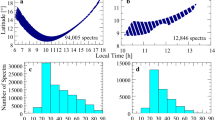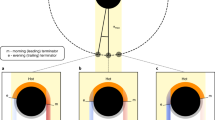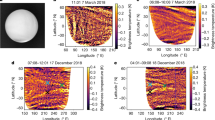Abstract
The 1980 encounter by the Voyager 1 spacecraft with Titan, Saturn's largest moon, revealed1,2 the presence of a thick atmosphere containing nitrogen and methane (1.4 and ∼0.05 bar, respectively). Methane was found to be nearly saturated at Titan's tropopause, which, with other considerations, led to the hypothesis that Titan might experience a methane analogue of Earth's vigorous hydrological cycle, with clouds, rain and seas3,4,5,6,7. Yet recent analyses of Voyager data indicate large areas of supersaturated methane, more indicative of dry and stagnant conditions8,9. A resolution to this apparent contradiction requires observations of Titan's lower atmosphere, which was hidden from the Voyager cameras by the photochemical haze (or smog) in Titan's stratosphere. Here we report near-infrared spectroscopic observations of Titan within four narrow spectral windows where the moon's atmosphere is ostensibly transparent. We detect pronounced flux enhancements that indicate the presence of reflective methane condensation clouds in the troposphere. These clouds occur at a relatively low altitude (15 ± 10 km), at low latitudes, and appear to cover ∼9 per cent of Titan's disk.
This is a preview of subscription content, access via your institution
Access options
Subscribe to this journal
Receive 51 print issues and online access
$199.00 per year
only $3.90 per issue
Buy this article
- Purchase on Springer Link
- Instant access to full article PDF
Prices may be subject to local taxes which are calculated during checkout




Similar content being viewed by others
References
Lindal, G. F. et al . The atmosphere of Titan: an analysis of the Voyager 1 radio-occultation measurements. Icarus 53, 348–363 (1983).
Lellouch, E. et al . Titan's atmospheric temperature profile: a reanalysis of the Voyager 1 radio-occultation and IRIS 7.7 micron data. Icarus 79, 328–349 (1989).
Lunine, J. I., Stevenson, D. J. & Yung, Y. L. Ethane ocean on Titan. Science 222, 1229–1230 (1983).
Flasar, F. M. Oceans on Titan? Science 221, 55–57 (1983).
Toon, O. B., McKay, C. P., Courtin, R. & Ackerman, T. P. Methane rain on Titan. Icarus 75, 255–284 (1988).
Eshleman, V. R., Lindal, G. F. & Tyler, G. L. Is Titan wet or dry? Science 221, 55–57 (1983).
Hunten, D. M. et al . in Saturn (eds Gehrels, T. & Matthews, M. S.) 671–759 (Univ. of Arizona Press, Tucson, 1984).
Courtin, R., Gautier, D. & McKay, C. Titan's thermal emission spectrum: reanalysis of the Voyager infrared measurements. Icarus 114, 144–162 (1995).
Samuelson, R. E., Nath, N. R. & Borysow, A. Gaseous abundances and methane supersaturation in Titan's tropopause. Planet. Space Sci. 45, 959–980 (1997).
Griffith, C. A., Owen, T. & Wagener, R. Titan's surface and trophosphere, investigated with ground-based, near-infrared observations. Icarus 93, 362–378 (1991).
Lemmon, M. T., Karkoschka, E. & Tomasko, M. Titan's rotation: surface feature observed. Icarus 103, 329–332 (1993).
Griffith, C. A. Evidence for surface heterogeneity on Titan. Nature 364, 511–513 (1993).
Noll, K. S., Geballe, T. S., Knacke, R. F. & Pendleton, Y. J. Titan's 5 μm spectral window: carbon monoxide and the albedo of the surface. Icarus 124, 625–631 (1996).
Muhleman, D. O., Grossman, A. W., Butler, B. J. & Slade, M. A. Radar reflectivity of Titan. Science 248, 975–980 (1990).
Smith, P. H. et al . Titan's surface revealed by HST imaging. Icarus 119, 336–349 (1996).
Combes, M. et al . Spatially resolved images of Titan by means of adaptive optics. Icarus 129, 482–497 (1997).
Lemmon, M. T., Karkoschka, E. & Tomasko, M. Titan's rotational light-curve. Icarus 113, 27–38 (1995).
Coustenis, A., Lellouch, E., Maillard, J. P. & McKay, C. P. Titan's surface: composition and variability from its near-infrared albedo. Icarus 118, 87–104 (1995).
Khare, B. N. et al . Optical constants of organic tholins produced in a simulated Titanian atmosphere: from soft X-ray to microwave frequencies. Icarus 60, 127–137 (1984).
Husson, N., Bonnet, B., Scott, N. A. & Chédin, A. The “GEISA” data bank, 1991 version (Int. note L.M.D. 163, Lab. de Météorologie Dynamique, Palaiseau, 1991).
Rages, K., Pollack, J. B. & Smith, P. H. Size estimates of Titan's aerosols based on Voyager high-phase-angle images. J. Geophys. Res. 88, 8721–8728 (1983).
McKay, C. P., Pollack, J. B. & Courtin, R. The thermal structure of Titan's atmosphere. Icarus 80, 23–53 (1989).
Toon, O. B., McKay, C. P., Griffith, C. A. & Turco, R. P. Aphysical model of Titan's aerosols. Icarus 95, 24–53 (1992).
Strong, K., Taylor, F. W., Calcutt, S. B., Remedios, J. J. & Ballard, J. Spectral parameters of self- and hydrogen-broadened methane from 2000 to 9500 cm−1 for remote sounding of the atmosphere of Jupiter. J. Quant. Spectrosc. Rad. Transfer 50, 363–429 (1993).
Calvin, W. M. & Clark, R. N. Modeling the reflectance spectrum of Callisto 0.25 to 4.1 μm. Icarus 89, 305–317 (1991).
Acknowledgements
We thank C. McKay for conversations on the weather, M. Flasar for suggestions that improved the paper, K. Noll for a helpful reading and C. B. Phillips for help in operating arduous radiative transfer codes. C.G. was supported by an NSF Young Investigator Award, the Research Corporation, and the NASA Planetary Astronomy Program.
Author information
Authors and Affiliations
Corresponding author
Rights and permissions
About this article
Cite this article
Griffith, C., Owen, T., Miller, G. et al. Transient clouds in Titan's lower atmosphere. Nature 395, 575–578 (1998). https://doi.org/10.1038/26920
Received:
Accepted:
Issue Date:
DOI: https://doi.org/10.1038/26920
This article is cited by
-
A post-Cassini view of Titan’s methane-based hydrologic cycle
Nature Geoscience (2018)
-
HCN ice in Titan’s high-altitude southern polar cloud
Nature (2014)
-
AVIATR—Aerial Vehicle for In-situ and Airborne Titan Reconnaissance
Experimental Astronomy (2012)
-
Locally enhanced precipitation organized by planetary-scale waves on Titan
Nature Geoscience (2011)
Comments
By submitting a comment you agree to abide by our Terms and Community Guidelines. If you find something abusive or that does not comply with our terms or guidelines please flag it as inappropriate.



